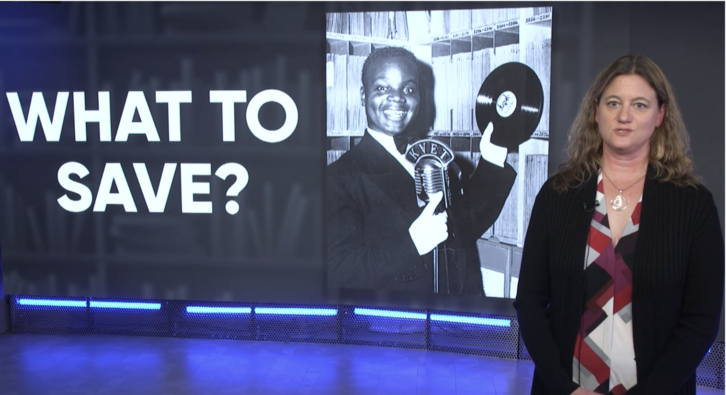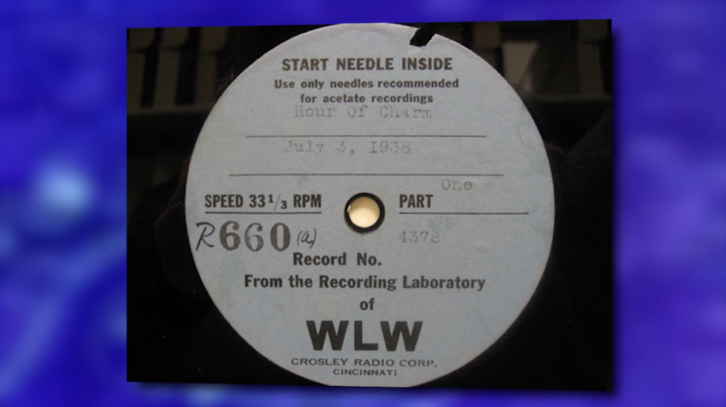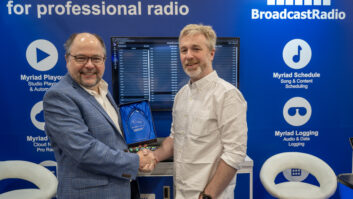Surprising as it may seem, precious items that represent our nation’s broadcast history have been rescued at the last minute — often from the trash bin.
It can happen for various reasons, from a lack of storage space to random whims of a station spring cleaning. Whatever the reason, the results are calamitous: the loss of vital voices, stories and images that document the history of broadcasting in the United States.
Encouraging stations to recognize the wealth of materials they may already have sitting in their facility was the goal of a webinar hosted by NAB and the Library of American Broadcasting Foundation (LABF).
Produced at the Washington, D.C.-based NAB Studio, in the first half of a two-part series, the webinar discussed the “whys” and “hows” of documenting and preserving broadcast history for future generations.
Preserving broadcast history is top of mind for NAB, said Jack Goodman, co-chair of LABF and moderator of the webinar, particularly as the organization celebrates 100 years of broadcasting. And there are important decisions that individuals, organizations and broadcasters should consider when contemplating archiving pieces of their own media library, said Laura Schnitker, curator of Mass Media and Culture at the University of Maryland’s Special Collections and University Archives.
For those interested in donating materials, keep the following in mind: materials should in some way document American broadcasting; materials must be unique, meaning they aren’t currently archived at another repository elsewhere; the media must have clear guidance on copyright restrictions; and the state of the media must be documented (for example, considering whether it needs to be cleaned and preserved as part of the archiving process).

Determining What to Save
According to Schnitker, the first question to ask is: Are the items in your possession the kinds of materials that can help tell the story of broadcasting? These can be original items like photos that tell a backstory about station operations. Take, for example, a photo of KVET radio talent Levada Durst, the first Black DJ in the state of Texas. Other items that can be saved and cataloged include written publications like books, newsletters, pamphlets and directories. These are good for illustrating historical context, Schnitker said.
One of the most compelling items to be archived is audio and video programming, Schnitker said. “I love to hear the voices, music and audience of the past. Hearing voices of the past is more humanizing or meaningful than reading news transcripts.” For example, the discovery of a glass transcription disk from 1938 — rescued from a radio station dumpster — offers a glimpse of pre-WWII history.
It may also be worthwhile to save program scripts, ad copy and production documents, Schnitker said. These often give a behind-the-scenes look at how programs were conceptualized and produced.

Create an Inventory
Schnitker said that one of the first steps to preservation is to create an inventory of the items. This inventory doesn’t have to be item by item, especially if there are a lot of materials, but it does need to show that there is some organized, intellectual control over a collection.
To start, capture basic information, such as format (such as cassette, CD, VHS, etc.); the title, topic or subjects being interviewed; the dates of the program; any notable names, topics or events associated with the program; and the location from which the material came. Schnitker stressed that this inventory doesn’t have to be complicated, just descriptive.
How to Store Materials
Where the materials are stored should be top of mind. Materials should be kept out of damp places like basements and attics, especially when it comes to A/V materials, because of problems that arise from humid rooms and mold. Digital items should be backed up on a stable storage system like a hard drive, USB or cloud platform.
How to Donate Materials
Once you have a general catalog of materials, there are a handful of national and regional archives out there, Schnitker said (see bottom of story). Start by visiting their webpages to determine what they collect and whether they specialize in a specific area.
Keep in mind that the best place for material might be a regional archive, particularly for material that has a strong regional identity. A few years ago, Schnitker’s team accepted the donation of several reels of audio programming containing a popular series produced at WJR in Detroit. “That’s a perfect example of something that should go to a regional institution, especially if they already have some local station archives,” she said.
What Happens After Donation
Once you’ve located a repository willing to accept your collection, the guiding mission is almost always the same: to preserve and create access to the materials. Processing archivists typically create finding aids that serve as guides or indexes as to what’s in a collection. Once that’s published online, researchers can contact the archive if they want to use the materials. To digitize A/V materials before submitting them to an archive, there are vendors around the country that can digitize media for a fee.
For materials that are accepted, keep in mind the main goal of a repository, said Mike Henry, a reference specialist at the University of Maryland’s Special Collections and University Archives.“Our main goal is not just preservation but also access — so that’s an important factor we consider when accepting a donation,” he said. An organization like Henry’s would want to know the size of the collation, the types of formats it has, the condition they are in and if there are any access restrictions placed on the collection.
As the nation celebrates 100 years of broadcasting, it’s important to work to preserve broadcast history for the future, said April Carty-Sipp, executive vice president of Industry Affairs for NAB. “We are all stewards of our rich broadcasting legacy.”
The topic of preservation will be further explored at the NAB Show New York in October during several sessions, such as a session on audio, video and document preservation and how it is being used to create original content for broadcasters as well as the session “Your Content is King: Preserve It.”
Those interested in donating materials to the University of Maryland’s Special Collections can contact Laura Schnitker at [email protected] or Michael Henry at [email protected].
National Archives
- American Heritage Center
- American Radio Archives
- The Library of Congress Division for Broadcast
- Special Collections at the University of Maryland
- UCLA Film and Television Archive
- Vanderbilt Television News Archive
- Wisconsin Historical Society Mass Communications History Collection






